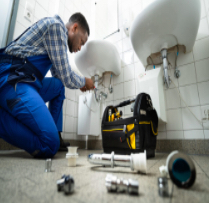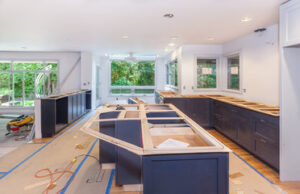Plumbing is the system of pipes, fixtures, and appliances that distribute water and waste in homes and businesses. Plumbers install, repair, and maintain these systems. They also provide services related to sewage and drainage.
Plumbers require a high level of education and training. They typically attend a trade school or community college and acquire on-the-job experience through an apprenticeship. For more information, click the Visit Website to proceed.
A water supply system is the infrastructure for collecting, transmitting, treating, storing, and distributing drinking water to meet residential, commercial, industrial, thermoelectric power, irrigation, and public needs such as fire fighting and street flushing. Depending on the water type, the system may include wastewater treatment, storage, and disposal. The water can be sourced through desalination from groundwater (aquifers), surface water (lakes and rivers), or the sea. Water treatment typically includes purification and disinfection through chlorination or fluoridation. Water is stored in reservoirs, cisterns, or underground tanks and distributed by pipes to homes, businesses, and other users. The system may also have pressurizing components, such as pumping stations, to lift water to higher levels for storage or delivery.
Various institutions are responsible for the policy and provision of urban water services, including municipal utilities and private companies. Governments play a role in regulating, planning, and providing emergency response. Private companies offer services like water management and distribution, similar to a municipality, but are typically less centralized.
Public water suppliers report data to State agencies for various reasons, including allocation programs; compliance with the Safe Drinking Water Act; environmental reporting and monitoring; State public health, conservation, or drought planning; and utility rate-setting and operations. Data vary by State. The most comprehensive public water supply records contain automated identification, geographic, and hydrologic information on the source and quantity of drinking water withdrawals and deliveries. These are usually based on meter readings and may include information about large industrial users and unaccounted-for water.
Waste disposal is removing, discarding, recycling, or destroying unwanted materials called waste. These materials can be organic or inorganic and liquid, solid or gaseous. It is an important aspect of environmental management that must be considered. Inefficient waste disposal can lead to water, soil, and air pollution. However, if followed correctly, it can reduce the harmful effects of these pollutants.
Most countries have strict laws governing the storage and disposal of waste. They require the segregation of biodegradable and non-biodegradable wastes. This ensures that a cleaner environment is maintained. Many cities have garbage disposal units that collect rubbish from homes and businesses. These units are staffed by trained professionals who sort and recycle waste. They also dispose of hazardous wastes. In addition, many cities use vacuum collection systems in which rubbish is transported along small bore tubes.
Garbage accumulation has become a major issue in modern times because of globalization and industrialization. Therefore, a more efficient waste disposal method is needed. One procedure involves a process in which non-reusable or unrecyclable wastes are separated and spread as a thin layer in specific low-lying areas around a city. After each layer of waste, a layer of soil is added. The area is then declared unfit for activities such as the construction of buildings and can only be used as a park or playground.
Another way to dispose of waste is through incineration. This high-temperature process converts solid organic waste into residue and gases. This technique can reduce the volume of solid waste by 80 to 95 percent. It is also environmentally friendly and can reduce greenhouse gases in the atmosphere.
Open burning of waste can also release toxic fumes and smoke. It may even cause harm to the body. In addition, waste is often dumped illegally into rivers and canals or filled in land depressions without proper administration. Such methods can lead to many problems, from soil degradation to harmful chemicals leaking into subsurface water sources.
Plumbing encompasses various activities, from installing and maintaining water supply systems to removing waste and preventing environmental pollution. It requires specialized training and knowledge, which can be obtained through trade school, community college, or on-the-job through a learn-while-you-earn apprenticeship. Plumbers also need to keep up with the latest industry trends and technology to ensure they provide the best services for their customers.
Plumbing is vital for any building, providing clean drinking water and removing waste materials. Without it, people would face several issues, from health risks to property damage. Keeping up with regular maintenance and addressing any problems promptly can help prevent these issues from occurring.
The water supply system consists of pipes, valves, and fixtures that provide clean, potable drinking water. It typically includes a water heater to provide warm water for bathing, washing dishes, and other uses. Plumbing also includes drainage systems that carry away sewage and waste materials, preventing the accumulation of harmful bacteria and germs in the home. This is important because fecal matter and other human waste can contain infectious diseases like cholera, typhoid, hepatitis, cryptosporidiosis, ascariasis, and schistosomiasis. These are transmitted when microbes enter a person’s body through drinking, eating, or contact with water contaminated with these substances.
Plumbing is one of any city’s most vital aspects, providing its occupants with clean water. It also helps get rid of waste through proper drainage. It is important to understand how your plumbing system works to fix any problems that may arise. This knowledge can help you save time and money on plumbing repairs and keep your system running properly.
Your home plumbing system consists of two separate subsystems: the freshwater supply and the wastewater system. The former delivers fresh water into your home through plastic, iron, or copper pipes. It then flows to your faucets and other water-using fixtures, such as toilets and showers. To deliver hot water, the system runs water through a water heater. The pressure from your home’s water meter keeps track of how much water you use, and the main water shut-off valve is usually located close to the meter.
The drain portion of your plumbing system takes waste water away from your fixtures and relies on gravity rather than pressure. The drainage pipes all pitch, or angle, downward towards the sewer line, allowing gravity to pull the waste along. The plumbing system also includes traps through sink drains to prevent sewage gasses from entering your home. These are usually referred to as P-traps, and they consist of a pipe that connects the drain opening to the trap.
Commercial plumbing systems are more complex than residential ones, as they must provide water for many more people daily. They must also follow strict health care laws, so their pipe fixtures are typically larger and of higher quality. They also require frequent maintenance and inspections to ensure they work properly.
In addition to pipes, the plumbing system consists of fittings and other components, such as valves, flanges, soldering rings, elbows, tees, and unions. It is important to select high-quality materials to ensure the plumbing system lasts long and remains in good condition. For example, copper tubing is available in four wall thicknesses: type DWV (thinest; only allowed for drain pipe per UPC), type L (standard for all other purposes), type K (medium), and type M (thickest; only permitted for water mains). The plumbing system includes air pressure regulators, check valves, and backflow preventers.
Aside from fixing leaks, clogged drains, and toilets, plumbers can also perform other related services. One such service is hydrojetting, used to clean sewer lines and other underground pipe systems. This service involves shooting highly pressurized water through the pipe, which can help clear out even the most stubborn clogs.
Another important service plumbers can offer is the installation of water heaters. These experts can install, repair, and maintain water heaters for residential and commercial buildings. They can also advise customers on the best heater based on their budget and needs.
Plumbers must also ensure compliance with local, State, and federal building codes and regulations. They must be able to interpret blueprints and plans, and they may need to submit reports and obtain permits for plumbing projects. Additionally, they may need to supervise contractors and subcontractors to ensure all work is done correctly and safely.

